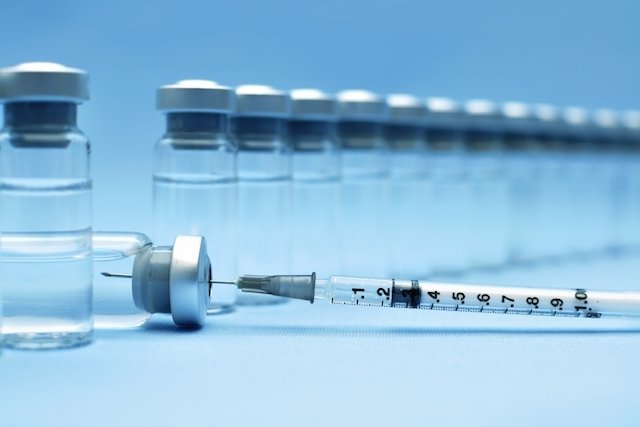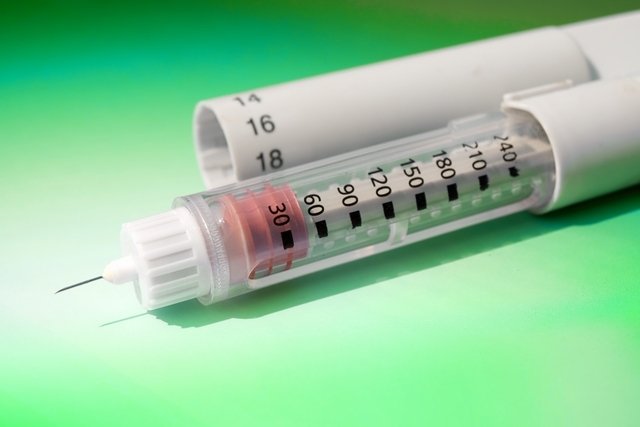Insulin is a hormone naturally produced by the body to control blood glucose levels, but when it is not produced in sufficient quantity or when its function is reduced, as happens in diabetes, it may be necessary to use synthetic and injectable insulin.
There are several types of synthetic insulin, which imitate the action of the natural hormone at every moment of the day, and which can be applied through daily injections into the skin with syringes, pens or small specialized pumps.
Synthetic insulin helps to normalize blood glucose levels and allows diabetics to maintain a healthy life and avoid the complications of diabetes. However, its use should only be started on the recommendation of a general practitioner or endocrinologist, as the type of insulin to be used, as well as its quantities, vary according to each person’s needs.

The main types of synthetic insulin vary according to the duration of action and the moment in which they should be applied:
1. Fast-acting insulin
Rapid-acting insulin has an almost immediate action, around 10 to 15 minutes after its application, and therefore should be administered right before a meal. Within this category, insulin lispro, aspart and glulisine can be found, which must be recommended by the general practitioner or endocrinologist according to each person’s needs.
This type of insulin can be found in pharmacies under the trade names NovoRapid, Aspart Fiasp or Lispro (Humalog).
2. Fast-acting inhalation insulin
Inhaled insulin is made up of insulin microspheres and should only be used by adults with diabetes. The spheres are absorbed quickly, taking effect within 10 to 15 minutes after inhalation. This type of insulin is contraindicated for people who smoke and for people with lung diseases such as COPD.
This insulin is available in the form of a single-use device, with different doses according to the doctor’s instructions, and it is recommended that it be used before meals. This type of insulin can be found under the trade name Afrezza.
3. Regular or short-acting insulin
This type of insulin takes effect within 30 minutes after its application, which is subcutaneous, lasting 3 to 6 hours. The doctor may recommend regular or short-acting insulin in the case of surgery or acute infections, for example.
This type of insulin can be found under the trade names Apidra, Novolin R, Humulin R or Actrapid.
4. Intermediate-acting insulin
Intermediate-acting insulin is a basal insulin that is used to maintain the amount of this hormone constant in the body for 12 to 18 hours, so the doctor may recommend two daily injections to maintain its effect in the body throughout the day. .
This insulin can be found under the trade names Humulin N or Humulin NPH, Densulin N, Insulex N, Novolin N, Insulatard or Insuman.
5. Long-acting insulin
This type of insulin is released continuously and slowly over 24 hours, so the amount of insulin in the blood remains constant to mimic basal and trough insulin throughout the day. Some types of long-acting insulin are glargine, detemir and degludec, which should be evaluated by a doctor in the case of pregnant women, as insulin is not indicated in all situations.
Long-acting insulin can be found under the brand name Lantus.
6. Combined insulin
Combination insulin preparations contain a mixture of rapid- or short-acting insulin with an intermediate-acting insulin. This eliminates the need to take insulin from more than one vial.
Combined insulin can be found under the trade names Humalog Mix 75/25 or Humulin 30/70
7. Ultra-long-acting insulin
Ultra-long-acting insulin lasts up to 36 hours, ensuring greater comfort for the person, as fewer injections are needed per day.
This type of insulin can be purchased in pharmacies under the trade name Tresiba.
Characteristics of each type of insulin
The characteristics that differentiate the main types of insulin are:
The onset of insulin action corresponds to the time it takes for insulin to start taking effect after administration and peak action is the time at which insulin reaches its maximum action.
Some diabetics may require rapid-acting, ultra-rapid-acting and intermediate-acting insulin preparations, called combined insulin, such as Humulin 70/30 or Humalog Mix, for example, to control the disease and is normally used to facilitate the its use and reduce the number of stings, especially by elderly people or those who have difficulty preparing insulin due to motor or vision problems. The onset of action, duration and peak depend on the insulin that makes up the mixture, and is generally used 2 to 3 times a day.
In addition to insulin injections applied with a specialized pen or syringe, you can also use an insulin pump, which is an electronic device that is attached to the body and releases insulin for 24 hours, allowing better control of sugar levels in the body. blood and diabetes, and can be used for individuals of all ages, generally with type 1 diabetes. Find out more about how to use and where to find the insulin pump.
How to apply insulin
For any type of insulin to be effective, it is essential to apply it correctly and, to do this, it is necessary:
- Make a small crease in the skin, before applying the injection, so that it is absorbed in the subcutaneous region;
- Insert the needle perpendicular to the skin and apply the medication;
- Vary injection sitesbetween the arm, thigh and belly and even in these places it is important to rotate, to avoid bruising and lipohypertrophy.
Furthermore, it is important to store the insulin, keeping it in the refrigerator until it is opened and after the package is opened, it must be protected from the sun and heat and must not be used for more than 1 month. Better understand the details of how to apply insulin.

Sign up for our newsletter and stay up to date with exclusive news
that can transform your routine!
Warning: Undefined array key "title" in /home/storelat/public_html/wp-content/plugins/link-whisper-premium/templates/frontend/related-posts.php on line 12
Warning: Undefined array key "title_tag" in /home/storelat/public_html/wp-content/plugins/link-whisper-premium/templates/frontend/related-posts.php on line 13




